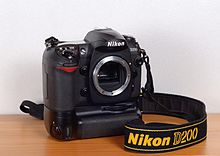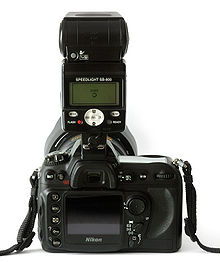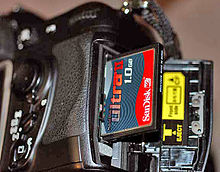Nikon D200
| Nikon D200 | |

|
|
| Type: | DX format -DSLR |
| Lens : | F bayonet |
| Image sensor : | CCD |
| Sensor size: | 23.6 mm x 15.8 mm |
| Resolution : | 10.2 megapixels |
| Image size: | 3,872 × 2,592 pixels |
| Pixel pitch (µm) : | 6.1 |
| Format factor : | 1.523 |
| File formats : | NEF (raw data) with 12 bit color depth per channel, NEF with almost lossless compression, JPEG with 8 bit color depth per channel, three image sizes, two compression levels, three quality levels (all freely combinable), NEF and JPEG at the same time |
| Exposure index : | ISO 100 to 1600, additionally up to 3200 |
| Viewfinder : | optical pentaprism finder |
| Field of view : | approx. 95% |
| Enlargement: | 0.94 times at 50 mm focal length |
| Screen : | Color TFT LCD |
| Size: | 2.5 inches |
| Resolution: | 320 × 240 pixels (76,800 pixels), 160 ppi |
| Number of continuous exposures: | 5 frames / second |
| Auto focus (AF) : | Nikon Multi-CAM1000 module |
| Exposure metering : | 3D color matrix metering II with 1,005 segment RGB sensor, center-weighted, circle diameter selectable, spot metering, in the middle of the active focus measurement field |
| Measuring range: | 0 to 20 EV (center-weighted and matrix metering), 2 to 20 EV (spot metering) |
| Correction : | −5 to +5 EV, selectable increments |
| Closure : | electronically controlled, vertical focal plane shutter |
| Shutter speed : | 30 to 1/8000 of a second, long exposure bulb |
| Lightning : | integrated, foldable |
| Guide number : | 12 |
| Flash control: | i-TTL (with external flash units e.g. SB-400 , SB-600 , SB-800 and SB-900 as well as the Nikon SU-800 IR flash remote control unit) |
| Lightning connection : | X-contact, standard ISO norm shoe |
| Synchronization : | on the first shutter curtain, on the second shutter curtain, slow synchronization, FP synchronization (for times below 1/250 s, only with external flash, e.g. SB-600/800) |
| Flash functions: | Red-eye reduction, modeling light, stroboscope: frequency, number and power of the flashes can be selected (also with internal flash), wireless control of AWL-compatible flash units via 4 channels (e.g. SB-600/800): 2 independent Configurable slave groups from any number of flash units (groups A and B) and internal flash as master (M) |
| White balance : | 6 presets, automatic, white balance measurement memory |
| Storage media : | CompactFlash memory cards (type I, II) and microdrives |
| Data interface : | USB 2.0 |
| Video interface: | PAL or NTSC, selectable |
| Power supply: | Lithium-ion battery EN-EL3e with 1,500 mAh, 7.4 V DC, optional handle MB-D200 with one or two batteries EN-EL3e or six mignon cells, optional power supply unit EH-6 AC |
| Casing: | Magnesium chassis with plastic cover, rubber seals against dust and moisture |
| Dimensions: | approx. 147 mm × 113 mm × 74 mm |
| Weight: | approx. 830 g (without battery and memory card) |
The Nikon D200 is a digital SLR camera from the Japanese manufacturer Nikon , which was launched on the market in December 2005.
technical features
The camera has a 10,2- Megapixel - CCD - image sensor in DX format. It comes from the Japanese manufacturer Sony . The format factor of the camera is 1.5. It uses the manufacturer's standard F-bayonet for interchangeable lenses and can also be combined with lenses without a processor.
Images can be recorded with a maximum resolution of 3872 × 2592 points, which corresponds to an effective 10.2 million pixels and results in raw data in the manufacturer's own NEF format of almost 16 MB in size. In addition to the raw data with 12 bit color depth per color channel and a compressed version, JPEG files with 8 bit color depth can be saved, either alone or in combination with NEF files. The sensor, which is equipped with an optical low-pass filter , supports exposure indices from ISO 100 to 1600 in 1/3, 1/2 or 1.0 EV steps. Other values, known as Boost , from ISO 2000 to 3200 can be set. The sensor is read out in parallel via four channels (1 × red, 1 × blue and 2 × green).
The camera's autofocus system (AF) is of the Multi-CAM 1000 type and uses either eleven small or seven large AF measuring fields. Depending on the selected mode, the camera detects moving objects and adjusts the focus. If an object leaves an AF point, it automatically switches to the next point. In order to be able to focus even in poor light conditions, the camera has a separate white AF auxiliary light, which can, however, be covered by lenses with a large diameter.
Four modes are available to the user for exposure control: (M) Manual, (A) Aperture priority , (S) Aperture priority and (P) Program priority . Each of the modes can be combined with one of three exposure metering methods: spot metering , center-weighted integral metering and 3D color matrix metering . In order to be able to carry out a matrix measurement even with older lenses without a processor, the user has to enter the maximum aperture and the focal length manually. The exposure can be corrected by +/- 5 EV in 1/3, 1/2 or 1 EV steps. The camera supports exposure bracketing ( AE bracketing ) with two to nine pictures, also in 1/3, 1/2 or 1 EV steps. In addition to AE bracketing , the camera also has white balance series for varying the white balance with a step size of up to 3 × 10 mired .
The shutter of the camera consists of an electronically controlled, vertical focal plane shutter and enables exposure times of 30 seconds up to 1/8000 of a second. The shortest flash sync time is 1/250 second. In the long exposure mode ("bulb"), any longer exposure times can be realized.
In series picture mode with a maximum speed of 5 pictures per second, depending on the memory card used , up to about 37 can be recorded in JPEG format or 22 in NEF format. The camera is equipped with an internal buffer memory that allows additional photographs to be taken while the images are being written to a memory card at up to approximately 9 MB / s.
It is possible to Compact Flash memory cards type I and II used as Microdrive cards.
The camera has a USB 2.0 high-speed output and a video output that can be set to the PAL or NTSC formats .
The camera's viewfinder shows 95% of the actual image section and enables adjustment from −2 to +1 spherical diopter . The viewfinder magnification is 0.94 times at a focal length of 50 mm.
The 2.5 ″ TFT LCD used in the camera has a QVGA resolution (320 × 240 pixels). The brightness can be adjusted with a backlight. Power is supplied by a 1500 mAh lithium-ion battery with 7.4 V. In connection with the optionally available vertical format handle, two lithium-ion batteries or six standard mignon cell batteries (AA) can be used.
The built -in focusing screen is optimized for AF operation and is supplemented by a focus control display in the viewfinder for manual focusing.
The camera also has an internal flash and a sealed metal housing. The assignment of individual control elements to functions can be redefined by the user within limits.
The camera is controlled by two processors . One is used for image processing , another for all other tasks.
Use of AI and AI-S lenses
Lenses without CPU ( AI , AI-S ) can be used for the camera almost without restriction . If the lens data ( focal length , largest aperture ) is entered manually , the matrix exposure measurement works with greater precision. The focal length and the set aperture are then correctly stored in the Exif data. However, program and shutter priority are not possible with such lenses.
equipment
F-bayonet lenses are offered by the manufacturer and by third-party companies. Various accessories are available for the camera, including GPS functionality ( GP-1 ), wireless LAN functionality, angle viewfinder , a portrait handle, remote release , external power supply and various flash devices.
The camera has the manufacturer's own accessory connection. A GPS receiver , for example, can be connected via the MC-35 cable to enable geotagging of the recordings.
history
At the time of publication, the manufacturer was selling two cameras, the D50 and D70 s , aimed at beginners. Furthermore, two models for professional photographers were offered with the models D2Hs and D2X . The D100 model, developed for professional and amateur photographers, was no longer technically able to meet the requirements of the market at the time and the D200 model was intended to close this gap in the offer.
Shortly after the camera appeared, the manufacturer had to admit problems with the image quality. In extremely high-contrast image situations, for example taking photos directly into a fluorescent tube with simultaneous overexposure , some models showed a noticeable stripe pattern. Affected cameras will be repaired under warranty.
See also
- List of Nikon DSLR cameras
- Fujifilm Finepix S5 Pro , a third-party camera based on this model, which was developed in cooperation
literature
- Frank Späth: Nikon D200. The book to the camera. Point of Sale Verlag, May 2006, ISBN 3-925334-69-6 .
- Rainer Dorau: The dbook for the Nikon D200. dpunkt Verlag, July 2006.
- Christian Haasz: Nikon D200. Franzis Verlag, Sept. 2006, ISBN 3-7723-7560-X .
- Michael Gradias: Nikon D200 paperback . Markt und Technik, Oct. 2006, ISBN 3-8272-4181-2 .
swell
- Nikon D200 at DPReview (English)
- Nikon D200 manual
Individual evidence
- ↑ Nikon (among other manufacturers) counts the subpixels of each pixel, i.e. H. the red, green and blue channel of each pixel individually, and therefore specifies the rear display with 76,800 [pixels] × 3 [colors] = 230,400 or approx. 230,000 pixels.
- ↑ Rob Galbraith: CF / SD Performance Database - Nikon D200 Write Speed ( Memento of the original from July 5, 2009 in the Internet Archive ) Info: The archive link was automatically inserted and not yet checked. Please check the original and archive link according to the instructions and then remove this notice.
- ↑ Product page GP-1 at Nikon.de accessed on April 4, 2012
- ↑ Brochure of the Nikon D200 ( page no longer available , search in web archives ) Info: The link was automatically marked as defective. Please check the link according to the instructions and then remove this notice. (Page 7 below)
Web links
- Product description on the Nikon international website (English)
- Test of the D200 from Digitalkamera.de
- Test of the D200 from LetsGoDigital
- The Nikon D200 at Digital Camera FAQ


